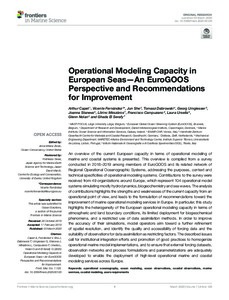| dc.contributor.author | Capet, Arthur | |
| dc.contributor.author | Fernández, Vicente | |
| dc.contributor.author | She, Jun | |
| dc.contributor.author | Dabrowski, Tomasz | |
| dc.contributor.author | Umgiesser, Georg | |
| dc.contributor.author | Staneva, Joanna | |
| dc.contributor.author | Mészáros, Lőrinc | |
| dc.contributor.author | Campuzano, Francisco | |
| dc.contributor.author | Ursella, Laura | |
| dc.contributor.author | Nolan, Glenn | |
| dc.contributor.author | El Serafy, Ghada | |
| dc.date.accessioned | 2020-11-13T17:57:43Z | |
| dc.date.available | 2020-11-13T17:57:43Z | |
| dc.date.issued | 2020 | |
| dc.identifier.citation | Capet, A.; Fernández, V.; She, J.; Dabrowski, T.; Umgiesser, G.; Staneva, J.; Mészáros, L.; Campuzano, F.; Ursella, L.; Nolan, G. and El Serafy, G. (2020) Operational Modeling Capacity in European Seas — An EuroGOOS Perspective and Recommendations for Improvement. Frontiers in Marine Science, 7:129. 19pp. DOI: 10.3389/fmars.2020.00129 | en_US |
| dc.identifier.uri | http://hdl.handle.net/11329/1443 | |
| dc.identifier.uri | http://dx.doi.org/10.25607/OBP-946 | |
| dc.description.abstract | An overview of the current European capacity in terms of operational modeling of marine and coastal systems is presented. This overview is compiled from a survey conducted in 2018–2019 among members of EuroGOOS and its related network of Regional Operational Oceanographic Systems, addressing the purposes, context and technical specificities of operational modeling systems. Contributions to the survey were received from 49 organizations around Europe, which represent 104 operational model systems simulating mostly hydrodynamics, biogeochemistry and sea waves. The analysis of contributions highlights the strengths and weaknesses of the current capacity from an operational point of view, and leads to the formulation of recommendations toward the improvement of marine operational modeling services in Europe. In particular, this study highlights the heterogeneity of the European operational modeling capacity in terms of atmospheric and land boundary conditions, its limited deployment for biogeochemical phenomena, and a restricted use of data assimilation methods. In order to improve the accuracy of their simulations, model operators aim toward a further refinement of spatial resolution, and identify the quality and accessibility of forcing data and the suitability of observations for data assimilation as restricting factors. The described issues call for institutional integration efforts and promotion of good practices to homogenize operational marine model implementations, and to ensure that external forcing datasets, observation networks and process formulations and parameterizations are adequately developed to enable the deployment of high-level operational marine and coastal modeling services across Europe. | en_US |
| dc.language.iso | en | en_US |
| dc.subject.other | Operational oceanography | en_US |
| dc.subject.other | Ocean modeling | en_US |
| dc.subject.other | Coastal modeling | en_US |
| dc.subject.other | Marine services | en_US |
| dc.subject.other | Ocean observations | en_US |
| dc.subject.other | Numerical modeling | en_US |
| dc.title | Operational Modeling Capacity in European Seas — An EuroGOOS Perspective and Recommendations for Improvement. | en_US |
| dc.type | Journal Contribution | en_US |
| dc.description.refereed | Refereed | en_US |
| dc.identifier.doi | 10.3389/fmars.2020.00129 | |
| dc.subject.parameterDiscipline | Parameter Discipline::Physical oceanography | en_US |
| dc.bibliographicCitation.title | Frontiers in Marine Sciences | en_US |
| dc.bibliographicCitation.volume | 7 | en_US |
| dc.bibliographicCitation.issue | Article 129 | en_US |
| dc.description.sdg | 14.A | en_US |
| dc.description.bptype | Best Practice | en_US |
| obps.contact.contactname | Vincente Fernandez | |
| obps.contact.contactemail | vicente.fernandez@eurogoos.eu | |
| obps.resourceurl.publisher | https://www.frontiersin.org/articles/10.3389/fmars.2020.00129/full | en_US |
 Repository of community practices in Ocean Research, Applications and Data/Information Management
Repository of community practices in Ocean Research, Applications and Data/Information Management
